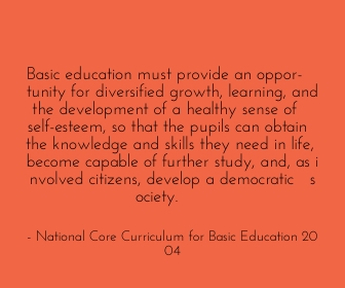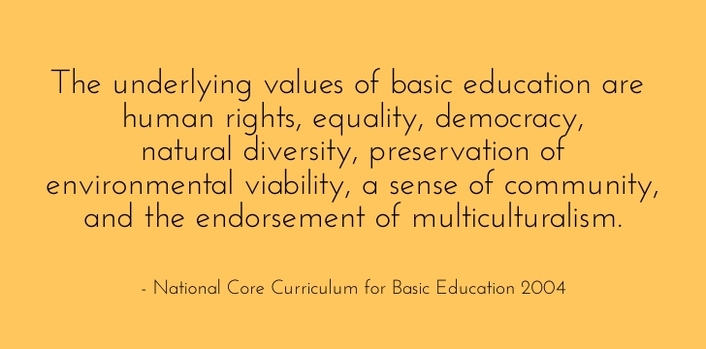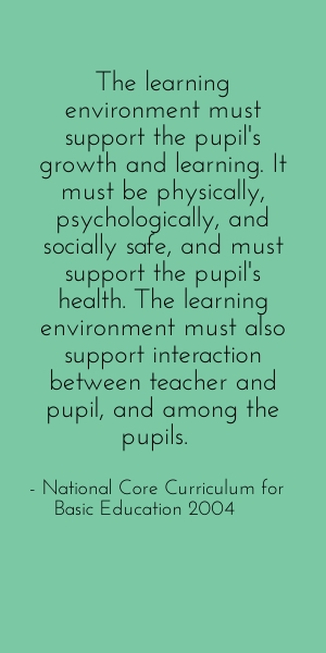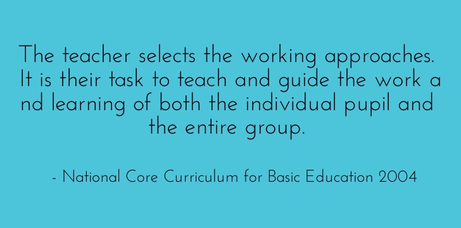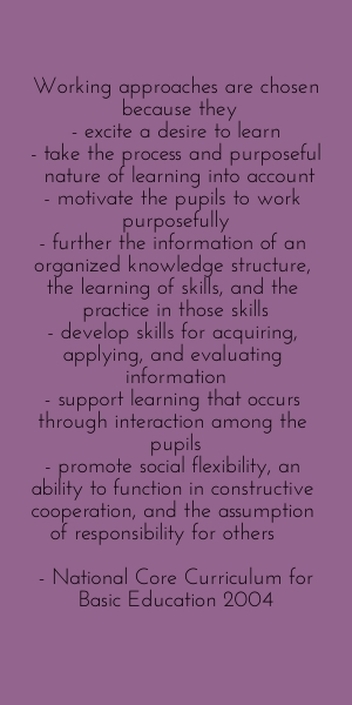Education in Finland
|
The Finnish education system is well-documented. I invite you to read about various aspects of education in Finland through the following resources and through my experiences in Finnish schools from February - May, 2015.
A Very Good Place to Start
|
Finnish Education in a Nutshell - This is an excellent overview of Finnish Education published by the The Finnish National Board of Education.
This document includes the following topics:
|
A Look Inside: Lessons from Finnish Schools
|
Most
of my time in Finland was spent making connections between theory and
practice. My foundational inquiry was how the ideals of the Finnish
National Core Curriculum of Basic Education is manifested in classrooms across the country.
I was fortunate to visit many schools across Finland. The map to the right shows places I traveled to meet with educators, students and community members as part of my Capstone Project. Below are slideshows that illustrate various dimensions of Finnish Education. Photographs include captions describing my observations. |
Compulsory education in Finland includes a year of pre-school (this measure went into effect in 2015) and nine years of basic eduction. I visited schools which served students from pre-school through grade 6 (primary) and schools for grades 7 - 9 (lower secondary.) Some schools included pre-school through grade 9. Post compulsory education is conceived as paths with no dead-ends. Students are offered a variety of educational paths that can include general upper secondary schools that prepare students for university studies. Other paths can include vocational upper secondary education and training through which students can acquire skills and knowledge to enter the work force or to continue their education at a Polytechnical college or through general upper secondary schools (and, possibly, continuing education at the University.)
The National Core Curriculum of Basic Education defines underlying values of basic education as “human rights, equality, democracy, natural diversity, preservation of environmental viability, and the endorsement of multiculturalism. Basic education promotes responsibility, a sense of community, and respect for the rights of freedoms for the individual.” These values reflect Finnish culture and situates schools as a vehicle to promote students’ cultural identity as a Finn and as a citizen of the world.
The National Core Curriculum of Basic Education defines underlying values of basic education as “human rights, equality, democracy, natural diversity, preservation of environmental viability, and the endorsement of multiculturalism. Basic education promotes responsibility, a sense of community, and respect for the rights of freedoms for the individual.” These values reflect Finnish culture and situates schools as a vehicle to promote students’ cultural identity as a Finn and as a citizen of the world.
School Places and Spaces
There are common elements to schools based on values that is reflected in a continuity of what education looks like across the country. School life in rural western Finland is not so different than school life in urban schools in Helsinki. While resources may vary, there is a baseline level of excellence visible in every school I visited, expressed through warm, nutritious meals served to children everyday; computers, projectors, and internet access in every classroom, developmentally appropriate play yards and meeting spaces for children; well-educated teachers who are valued and trusted to deliver the curriculum as they see fit; educational resources including manipulatives, textbooks and workbooks, computer labs, musical instruments and facilities like cafeterias, gymnasiums, libraries and specialty classrooms for visual arts, textile arts and sewing, woodworking, and teacher lounges where teachers meet in between classes, promoting a positive, collegial working environment (centered around coffee.) Schools exude a relaxed, nurturing atmosphere in which students are respected and supported.
A whole-child, developmental approach is evident through the number of hours of instructIon for skill and knowledge acquisition at each grade level. I observed this whole-child approach through the primary school structure of 45-minute classes followed by a 15-minute break in which students were outside (when the temperature is minus 20 degrees Celsius, students may stay inside for breaks.) For lower and upper secondary students, breaks are given in 15-minute and 30-minute intervals throughout the day. In my experiences, most adolescent learners do not go outside to play; however, schools have spaces for students to socialize with peers that always include a variety of seating options and often include ping pong tables (I’ve also seen coffee cocoa machines available for students.) Students are additionally nurtured and supported in their development through rich curricula inclusive of the visual arts, foreign language and mother tongue instruction, music, and physical education.
A whole-child, developmental approach is evident through the number of hours of instructIon for skill and knowledge acquisition at each grade level. I observed this whole-child approach through the primary school structure of 45-minute classes followed by a 15-minute break in which students were outside (when the temperature is minus 20 degrees Celsius, students may stay inside for breaks.) For lower and upper secondary students, breaks are given in 15-minute and 30-minute intervals throughout the day. In my experiences, most adolescent learners do not go outside to play; however, schools have spaces for students to socialize with peers that always include a variety of seating options and often include ping pong tables (I’ve also seen coffee cocoa machines available for students.) Students are additionally nurtured and supported in their development through rich curricula inclusive of the visual arts, foreign language and mother tongue instruction, music, and physical education.
School Lunch
|
Children in Finland are entitled to a a free meal every school day. Providing lunch daily to all students is one visible, primary way in which Finland strives to offer equal access to education. These meals also promote healthy eating habits. I had the privilege of partaking in several school meals along side students and teachers. Lunch rooms are comfortable and promote social interaction. In each setting I visited, students were calm, respectful and responsible, having learned how to serve themselves from the food line, the norms of eating in a community, and how to take care of food waste and dishes.
Each school has its own kitchen and staff where these well-balanced, healthful, and tasty meals are prepared. There are accommodations for students with food allergies and other dietary restrictions. |
Read more about school lunch in Finland at
http://www.oph.fi/download/155535_School_meals_in_finland.pdf |
Teacher Rooms
Each school has a teacher work room/ lounge that is well-used. In many schools, teachers have individual desks where they can work and lockers where they can keep their personal items. All rooms include a variety of tables and comfortable, colorful spaces with couches, cushions, chairs, curtains. A common feature to each room - a coffee maker. Teachers meet in these spaces before school, during breaks throughout the day (in primary school, students will often have 45-minute classes followed by 15-minute breaks. During those breaks, you'll find the teachers in the lounges, drinking coffee and enjoying each others' company.) I loved being in these spaces for teachers that, so clearly, support teacher health and well-being through collegial interaction and dietary sustenance.
|
|
